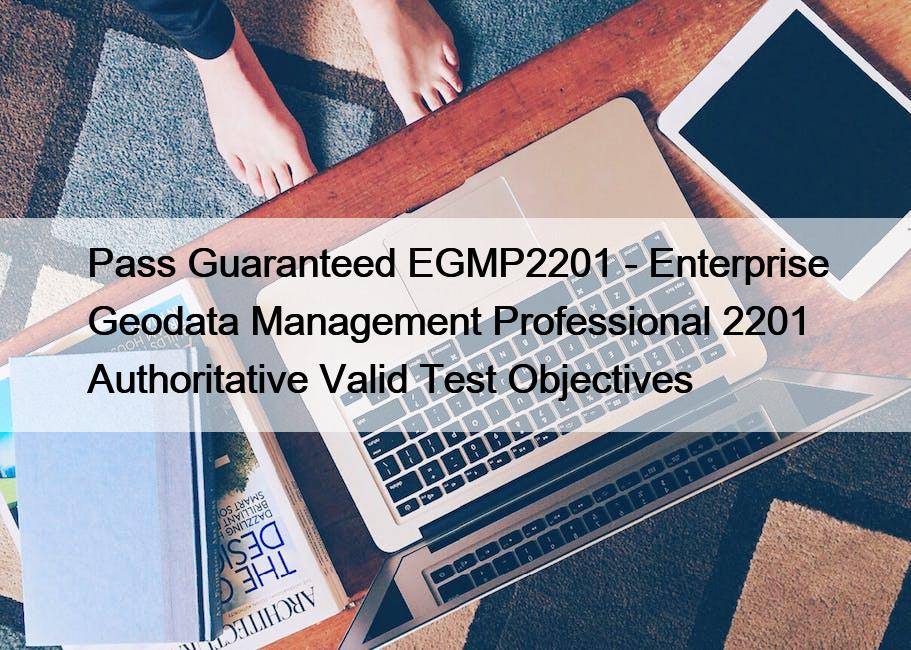Most Popular
 AD0-E502 Valid Exam Practice, Learning AD0-E502 Materials
AD0-E502 Valid Exam Practice, Learning AD0-E502 Materials
Will you feel nervous while facing a real exam environment? ...
 API-577 Valid Exam Testking | API-577 Answers Real Questions
API-577 Valid Exam Testking | API-577 Answers Real Questions
There is no doubt that if you pass the API-577 ...
 Reliable Salesforce MuleSoft-Platform-Architect-I Real Test & Valid Test MuleSoft-Platform-Architect-I Experience
Reliable Salesforce MuleSoft-Platform-Architect-I Real Test & Valid Test MuleSoft-Platform-Architect-I Experience
2025 Latest Prep4sureExam MuleSoft-Platform-Architect-I PDF Dumps and MuleSoft-Platform-Architect-I Exam Engine ...



Pass Guaranteed EGMP2201 - Enterprise Geodata Management Professional 2201 Authoritative Valid Test Objectives

As we all know, a good EGMP2201 Exam Torrent can win the support and fond of the customers, EGMP2201 exam dumps of are just the product like this. With high pass rate and high quality, we have received good reputation in different countries in the world. We are a professional enterprise in this field, with rich experience and professional spirits, we have help many candidates pass the exam. What’s more, the free update is also provided.
Esri EGMP2201 (Enterprise Geodata Management Professional 2201) Certification Exam is a credentialing program designed for GIS professionals who specialize in managing geospatial data in an enterprise environment. Enterprise Geodata Management Professional 2201 certification exam is specifically targeted towards those who work with Esri software and applications, and are seeking to validate their knowledge and skills in geodata management.
The EGMP2201 Exam covers a range of topics including geodatabase design, data quality control, data sharing, and security. It is a rigorous exam that requires a thorough understanding of the principles and practices of geodata management. Professionals who pass the EGMP2201 exam are recognized as experts in the field of enterprise geodata management and are highly valuable assets to organizations that rely on geospatial data.
>> EGMP2201 Valid Test Objectives <<
EGMP2201 Pdf Format | EGMP2201 Dump
If you are still struggling to prepare for passing EGMP2201 certification exam, at this moment 2Pass4sure can help you solve problem. 2Pass4sure can provide you training materials with good quality to help you pass the exam, then you will become a good Esri EGMP2201 certification member. If you have decided to upgrade yourself by passing Esri Certification EGMP2201 Exam, then choosing 2Pass4sure is not wrong. Our 2Pass4sure promise you that you can pass your first time to participate in the Esri certification EGMP2201 exam and get Esri EGMP2201 certification to enhance and change yourself.
To prepare for the EGMP2201 certification exam, candidates can take advantage of a variety of resources, including online training courses, instructor-led workshops, and study materials provided by Esri. Candidates can also gain practical experience by working with enterprise geospatial data and using Esri's software solutions. Passing the EGMP2201 Certification Exam requires a strong understanding of enterprise geodata management principles and practices, as well as a proficiency in using Esri's software solutions.
Esri Enterprise Geodata Management Professional 2201 Sample Questions (Q19-Q24):
NEW QUESTION # 19
An organization needs to reduce the number of RDBMS users. ArcGIS Enterprise and ArcGIS Pro are implemented. Editors need to isolate edits and ensure that edits are reviewed before becoming public.
Which editing model should the GIS administrator implement?
- A. Traditional versioning
- B. Branch versioning
- C. Nonversioned editing
Answer: A
Explanation:
Understanding the Scenario:
* Editors need to isolate their edits so that changes are not immediately visible to others.
* Edits must bereviewed before becoming public, indicating a requirement for a structured approval process.
* The organization aims to reduce the number of RDBMS users, which suggests centralized management of access and permissions.
Editing Models Overview:
* Branch Versioning:Designed for web-based workflows and does not require direct RDBMS access for each editor. However, edits made in branch versioning are inherently collaborative and are not isolated unless explicitly controlled through a branch-per-user workflow, which adds complexity.
* Traditional Versioning:
* Supports isolated editing through private versions.
* Editors can create their own versions, make changes, and submit them for review by reconciling and posting to the default version.
* Direct access to the RDBMS is centralized, reducing the need for individual RDBMS users.
* Nonversioned Editing:Does not support isolated edits or versioned workflows, making it unsuitable for this scenario.
Steps to Implement Traditional Versioning:
* Register the feature class asversionedin the enterprise geodatabase.
* Allow editors to createprivate versionsfor making isolated edits.
* Implement a workflow for reconciling and posting edits after review.
References:
* Esri Documentation: Traditional Versioning.
* Versioned Editing Best Practices: Guidelines for isolating and reviewing edits.
Why the Correct Answer is B:Traditional versioning meets all requirements: it isolates edits, allows for review before posting, and reduces the number of RDBMS users through centralized version management.
Branch versioning is web-centric and lacks the structured review process, while nonversioned editing does not support isolation or versioning.
NEW QUESTION # 20
After running a Compress, the GIS administrator needs to check if the Adds and Deletes tables for Buildings are empty before unregistering as versioned.
What should be referenced by the GIS administrator?
- A. gdbjtems
- B. table_registry
- C. sdejayers
Answer: C
Explanation:
To determine if theAddsandDeletestables for the "Buildings" dataset are empty before unregistering as versioned, the GIS administrator needs to reference thesde_layerstable.
1. Purpose of the sde_layers Table
* Thesde_layerstable tracks the relationship between base tables and the associated delta tables (Adds and Deletes).
* For each versioned dataset, the sde_layers table contains entries linking the dataset to its corresponding A and D tables (e.g., A_<ObjectID> and D_<ObjectID>).
2. Steps to Verify Adds and Deletes
* Identify theObjectIDof the Buildings dataset in thesde_layerstable.
* Query the Adds table (A_<ObjectID>) and Deletes table (D_<ObjectID>) associated with the Buildings dataset:
SELECT COUNT(*) FROM A_<ObjectID>;
SELECT COUNT(*) FROM D_<ObjectID>;
* If both queries return 0, the Adds and Deletes tables are empty, and it is safe to unregister the dataset as versioned.
3. Why Not Other Options?
* table_registry: This table tracks registered datasets but does not provide information about delta tables or their contents.
* gdb_items: This table stores metadata for datasets but does not have details on delta table contents.
References from Esri Documentation and Learning Resources:
* Compressing a Geodatabase-ArcGIS Pro Documentation
* Delta Tables in Versioned Geodatabases
Conclusion:
The GIS administrator must query thesde_layerstable to verify the Adds and Deletes tables before unregistering the dataset as versioned.
NEW QUESTION # 21
A GIS analyst needs to share a large repository of lidar data with the organization. This lidar data will have surface constraints applied for breaklines.
Which type of dataset should the GIS analyst use?
- A. Feature dataset
- B. Mosaic dataset
- C. LAS dataset
Answer: C
Explanation:
Understanding the Scenario:
* The GIS analyst needs to share a large repository oflidar data.
* The data includes surface constraints like breaklines, which are used to enforce terrain or surface rules.
Dataset Types Overview:
* Mosaic Dataset:Designed for managing large collections of raster data, such as imagery or elevation grids. It is not specifically optimized for lidar point cloud data.
* Feature Dataset:A container for related feature classes in a geodatabase. It is unrelated to managing lidar data or surface constraints.
* LAS Dataset:A specialized dataset designed for managing lidar point clouds. It supports point classification, surface constraints (like breaklines), and efficient querying or visualization of lidar data.
Steps to Create and Share a LAS Dataset:
* Create a LAS dataset in ArcGIS Pro and add lidar files (LAS or ZLAS format).
* Define surface constraints (breaklines) in the LAS dataset properties.
* Share the LAS dataset as a service or package for organizational access.
References:
* Esri Documentation: LAS Datasets.
* Managing Breaklines in LAS Datasets: Instructions for incorporating surface constraints.
Why the Correct Answer is C:LAS datasets are explicitly designed for managing and sharing lidar data with surface constraints like breaklines. Mosaic and feature datasets are unsuitable for this purpose.
NEW QUESTION # 22
An organization has a web service that must always be available. This service reads data from a feature class in an enterprise geodatabase. The GIS administrator needs to update the schema of the feature class.
Which workflow should be used?
- A. Disable schema locking on the service
- B. Run the Alter Field geoprocessing tool
- C. Delete the spatial index
Answer: A
Explanation:
Scenario Overview:
* The organization has a web service thatmust always be available.
* The service reads data from afeature classin an enterprise geodatabase.
* The GIS administrator needs to update theschemaof the feature class.
Why Disable Schema Locking?
* By default, ArcGIS services enforceschema lockingto ensure data consistency while the service is active. This prevents any modifications to the feature class schema (e.g., adding fields, altering attributes) while the service is running.
* Disabling schema locking allows schema updates to occur without disrupting the service's availability.
(ArcGIS Documentation: Schema Locking)
Steps to Disable Schema Locking:
* Access the ArcGIS Server Manager.
* Locate the web service and open itsservice properties.
* In the advanced settings, disable theschema lockingoption.
* Perform the required schema updates (e.g., adding fields or modifying the feature class).
* Re-enable schema locking if necessary for normal operation.
Alternative Options:
* Option B: Run the Alter Field geoprocessing tool
* This tool modifies fields but cannot execute schema changes while schema locks are active.
* Option C: Delete the spatial index
* Deleting the spatial index is unrelated to schema changes and could degrade query performance.
Thus, the correct workflow is todisable schema locking on the serviceto allow schema changes without disrupting the web service.
NEW QUESTION # 23
A data owner creates a one-way replica parent-to-child for a single feature class to share data from a production geodatabase to a public-facing geodatabase.
* The data owner synchronizes once a week to share updated data
* In time, the data owner wants to add a new attribute field/field type and calculates new attribute values
* The data owner synchronizes the replicas, but the new field and values are not present in the child replica
* In the public-facing geodatabase, the data owner adds the same attribute field and field type
* The data owner synchronizes the replicas again, and the values are not replicated in the child replica How should the data owner resolve this issue?
- A. Unregister the replica pairs, recreate the replica, and Synchronize Changes
- B. Unregister the replica pairs, run Feature Compare and Synchronize Changes
- C. Unregister the replica pair?, run Enable Replica Tracking and Synchronize Change?
Answer: A
Explanation:
Scenario Overview:
* A one-way replica from parent to child geodatabase is created for a single feature class.
* The data owner adds anew attribute fieldin the parent geodatabase, calculates values, and attempts to synchronize the replica.
* The new field and its values do not appear in the child replica, even after manually adding the field to the child geodatabase.
Why Recreate the Replica?
* The issue arises becauseschema changes(e.g., adding new fields) are not automatically propagated in one-way replication workflows. Synchronization only applies to data changes, not schema updates.
* To ensure the schema changes are recognized, thereplica pair must be recreatedwith the updated schema.(ArcGIS Documentation: Geodatabase Replication and Schema Changes) Steps to Resolve the Issue:
* Unregister the Replica:Remove the existing replica pair from both the parent and child geodatabases.
* Recreate the Replica:Create a new one-way replica between the parent and child geodatabases. This new replica will include the updated schema.
* Synchronize Changes:Perform synchronization to transfer data, including the new field and calculated values, to the child geodatabase.
Alternative Options:
* Option A:Enabling replica tracking does not address schema synchronization and would not resolve the issue.
* Option B:Running Feature Compare is helpful for analyzing schema differences but does not propagate schema changes.
Thus, the data owner mustunregister the replica pairs, recreate the replica with the updated schema, and synchronize changesto resolve the issue.
NEW QUESTION # 24
......
EGMP2201 Pdf Format: https://www.2pass4sure.com/ArcGIS-Enterprise/EGMP2201-actual-exam-braindumps.html
- Pass Guaranteed Efficient Esri - EGMP2201 Valid Test Objectives 🎈 The page for free download of ⮆ EGMP2201 ⮄ on ➡ www.examcollectionpass.com ️⬅️ will open immediately 🏵Reliable EGMP2201 Test Guide
- EGMP2201 Exam Dumps Get Success With Minimal Effort ⛑ The page for free download of ☀ EGMP2201 ️☀️ on ➥ www.pdfvce.com 🡄 will open immediately 🚧EGMP2201 Valid Test Papers
- Valid EGMP2201 Valid Test Objectives by www.passtestking.com 👍 Download ✔ EGMP2201 ️✔️ for free by simply entering ✔ www.passtestking.com ️✔️ website 📂EGMP2201 Reliable Exam Guide
- EGMP2201 New Braindumps Pdf 🖊 Reliable EGMP2201 Exam Guide 😧 EGMP2201 Real Questions 🕍 Download ▛ EGMP2201 ▟ for free by simply searching on ▷ www.pdfvce.com ◁ 🐈EGMP2201 Actual Test Pdf
- EGMP2201 Exam Sample Questions 👊 EGMP2201 Exam Sample Questions 🔩 EGMP2201 Valid Test Papers 😹 Simply search for ✔ EGMP2201 ️✔️ for free download on 《 www.free4dump.com 》 🦽EGMP2201 Exam Sample Questions
- Take Your Exam Preparations Anywhere with Portable Esri EGMP2201 PDF Questions from Pdfvce 🦠 Download ⇛ EGMP2201 ⇚ for free by simply searching on ➠ www.pdfvce.com 🠰 👏EGMP2201 Test Discount
- Test EGMP2201 Objectives Pdf 💚 EGMP2201 Test Collection Pdf 🕢 Reliable EGMP2201 Test Guide ➰ Go to website “ www.dumps4pdf.com ” open and search for ▶ EGMP2201 ◀ to download for free 📍EGMP2201 Exam Guide Materials
- Valid EGMP2201 Valid Test Objectives by Pdfvce 🕛 ➤ www.pdfvce.com ⮘ is best website to obtain ➡ EGMP2201 ️⬅️ for free download 🏂EGMP2201 Test Dumps Demo
- Latest EGMP2201 Exam Book 🐤 EGMP2201 Exam Guide Materials 📗 Test EGMP2201 Objectives Pdf 🚠 Easily obtain ➥ EGMP2201 🡄 for free download through ⏩ www.prep4pass.com ⏪ 🧔Latest Real EGMP2201 Exam
- Free PDF Quiz 2025 Esri EGMP2201 – High-quality Valid Test Objectives 📻 Download [ EGMP2201 ] for free by simply entering ➡ www.pdfvce.com ️⬅️ website 🍂EGMP2201 Test Collection Pdf
- EGMP2201 Valid Test Papers 🔣 Reliable EGMP2201 Test Guide 🧏 Test EGMP2201 Valid 🩸 Copy URL 《 www.real4dumps.com 》 open and search for ➥ EGMP2201 🡄 to download for free 🕍Reliable EGMP2201 Exam Guide
- EGMP2201 Exam Questions
- learn.digixeno.in frearn.com www.educateonlinengr.com www.medicalup.net elearning.investorsuniversity.ac.ug karltay541.dreamyblogs.com brightstoneacademy.com karltay541.blogacep.com phdkhulani.com skillrising.in
Tags: EGMP2201 Valid Test Objectives, EGMP2201 Pdf Format, EGMP2201 Dump, New EGMP2201 Exam Fee, Real EGMP2201 Torrent